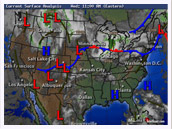
Montillus ( Old Man ) Beatty purchased the Lander Ranch in the Spring of 1896. He was one of the three white men in the Oasis Valley. He settled here with his Paiute wife to farm and raise his family. Being an old miner, he always opened his home to anyone who would pass through on their way to the mines in Death Valley .
In August of 1904 Shorty Harris and Ed Cross found gold in a rock and the Bullfrog Mining District was born.
Robert Montgomery had found several mines in the Panamints, so when he heard of the Harris/Cross find, he hired a Shoshone Indian to help him locate a claim in the new mining area. The Montgomery Shoshone was found and thus began one of the biggest and shortest lived gold rushes in the Death Valley Area.
Bob Montgomery purchased a large area of the Beatty Ranch to plat a town site. The town of Bullfrog was in place, but they had no water. With Bob Montgomery's town, the miners and businessmen would have plenty of water, which made this town much more appealing.
Bob Montgomery named his town site Beatty, in honor of Montillus Beatty. Mr. Beatty was the first Postmaster and seemed to thrive on all the activity happening on his old ranch.
Three months after the start of Beatty, the Bush Brothers platted the town of Rhyolite. Although Beatty never reached a population much over 650, it was destined to become the supply center for all the other mining towns in the Bullfrog Mining District.
By 1906, railroads had made it to Beatty. With an Ice House, several Hotels, Saloons, a Newspaper, Fresh Produce, Meat Markets and General Mercantile, Beatty had everything that anyone could want, including plenty of water.
In March of 1907, one of the most important real estate transactions occurred. Robert Montgomery sold the town site of Beatty to Dr. W.S. Phillips of Chicago and E.S. Hoyt of Tonopah for $100,000.00. Wanting to promote their new town , they backed Railroad Days, and it was said to be one of the biggest seen in Nevada. A train from Los Angeles, California carried many investors and party goers' free of charge to the town of Beatty, where they were treated to fresh fruits, seafood and champagne as they disembarked from the train. Beatty wined and dined their new investors. Hoyt and Phillips promoted Beatty in newspapers throughout the world. Looking towards England for funding some of the ads were not what they seemed. They had pictures of paddle boats loaded with ore on its way to Goldfield, Nevada to be processed on the Amargosa River. Although it was later found that Dr. Phillips had started one of the largest scams of the time, it gave Beatty the jump start it needed. With no town manager or city government to promote their town and the mining interests, they elected their own and kept Beatty alive.
With new roads being built between Beatty and outlying towns, it was becoming the center of travel as early as 1906. With passenger trains, stage coaches and automobile stages, you could go just about anywhere from one convenient location. As the gold ran out, towns started collapsing, and by 1914 Beatty had become the largest town in the Bullfrog Mining District. Beatty remained a railroad hub until 1940 when the railroad was placed into maintenance. By 1942, the tracks were pulled up by the Department of War Office for use in World War II. Beatty now had to depend on the automobile traffic and newly developed Highways from Reno to Las Vegas. Although still a mining town, Beatty would start catering more and more to tourism. Known as " The Gateway To Death Valley" since 1933 when Death Valley was declared a National Monument by President Herbert Hoover. Beatty has embraced tourism by expanding economic opportunities to provide restaurants, motels and information to the area's historic sites.
With the conception of the Nevada Test Site and the development of the Atomic Bomb, Beatty took on a new task. Many of the young men growing up in Beatty started working at the test site, which is still one of the employers of many Beatty residents today. From Mining to Railroads, Atomic Bombs and Nuclear Arms Testing to Tourism, Beatty has had many faces since October of 1904. Still a thriving community of 1,000 residents, Beatty offers diverse opportunities to visitors and residents alike.
Sitting on the eastern border of Death Valley National Park, Beatty lives on with simple pleasures, mining heritage, and pride. Welcome to the history of Beatty, where most of the buildings on Main Street are the same ones that have been here since the beginning, and like Beatty itself have been through many changes over the years, but are still standing strong. Come for a visit and step back into time.


